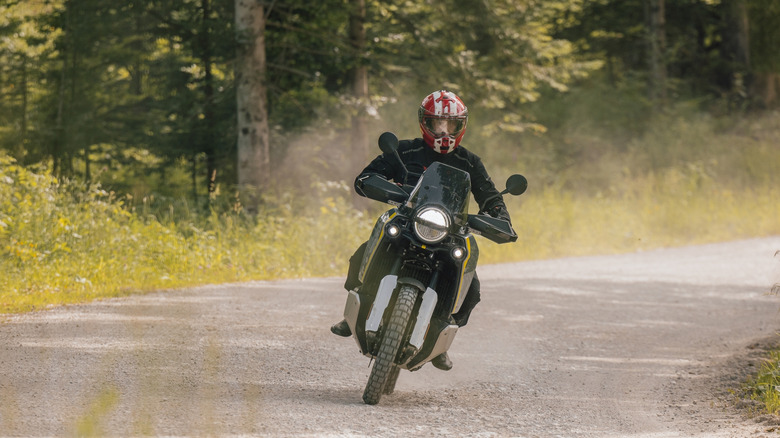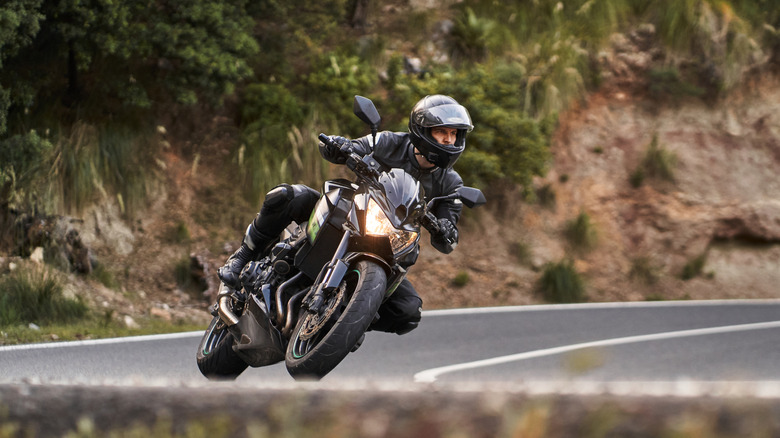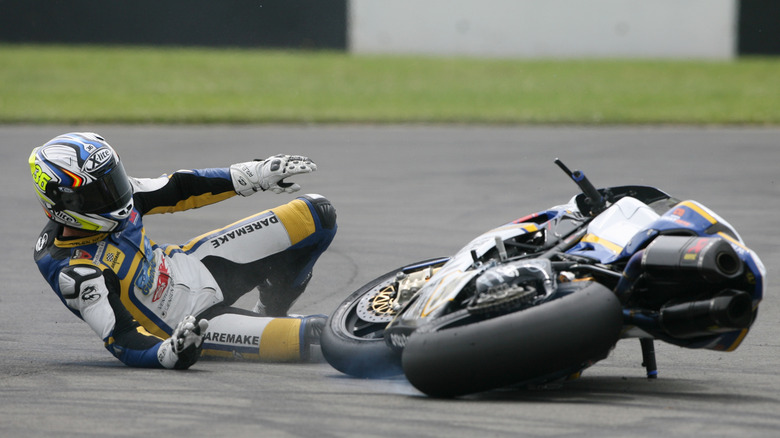
Motorcyclists aren't trying to earn style points when they lean into a curve in the road, nor are they showing off with some dangerous gravity-defying stunt. It's a safety measure, and it's an absolute must for bikers to maneuver corners properly. Unlike cars, it's not enough for motorcycles to just steer into a turn using the handlebars. At any speed faster than a crawl, a biker has to lean into a curve to make it around safely. The science is simple: This sideways lean effectively counteracts the powerful
forces of gravity on both the rider and the bike itself. Without it, the motorcycle would likely crash.
See, when a motorcycle enters a turn, it starts being pulled on by centrifugal force,the outward pull you feel when rounding a curve. Centrifugal force pushes the motorcycle away from the direction it's turning, while, at the same time, gravity is pulling the bike straight down. All the while, there's friction between the tires and the road trying to keep the bike upright and on track. To balance these opposing forces, the rider has to lean into the curve. This shifts the center of gravity (COG) inward, helping the bike stay stable and keeping the rider in control. If you lean too far, you risk sliding. If you don't lean enough, the centrifugal force will push the bike outward, giving you less grip and still that risk of sliding.
Read more: Every Motorcycle Keanu Reeves Owns In His Stunning Collection
The Physics Behind The Lean

How does something as simple as a lean work to fight the forces of gravity? Think of the bike's center of gravity as a constantly shifting point created by the weight of both the bike and rider. When a motorcycle is upright and moving straight, this point sits nice and vertical above the tires and the road. It's called the rider's triangle, and it's enough to keep everything balanced and steady... until a turn begins.
If you were to simply steer the handlebars into the turn while remaining upright, the center of gravity would stay too high. This would run the risk of the bike tipping due to all the centrifugal force. Instead, the rider has to countersteer, leaning the bike by gently pushing the handlebars down into the turn, helping the rider redirect the center of gravity inward toward the curve's center. This lean creates a balance between gravity pulling downward and the centrifugal force pulling outward. And if you have really high handlebars, that center of gravity is going to be even tougher to maintain.
The One Mistake That Could Undermine The Lean

Of course, new riders run the risk of off-leaning. This happens when the rider leans the bike, but not their body. Off-leaning shifts the center of gravity away from the inside of the corner, making the outward-pushing centrifugal force even stronger. To make up for it, the bike has to lean even more aggressively than usual, bringing the tires dangerously close to their edge grip limit,where slipping becomes a serious risk. This is the point you might see an experienced motorcyclist put their knee down.
When reducing ground clearance like this on uneven pavement or during high-speed cornering, you increase the likelihood of scraping the footpegs or exhaust pipes on the ground. When this happens, you're looking at a major crash risk. On wet or loose surfaces, that risk only gets greater. That's why it's so important to get the lean right, bringing both the bike and your body into the turn together to keep the center of gravity lower and inward.
Want the latest in tech and auto trends? Subscribe to our free newsletter for the latest headlines, expert guides, and how-to tips, one email at a time.
Read the original article on SlashGear.










